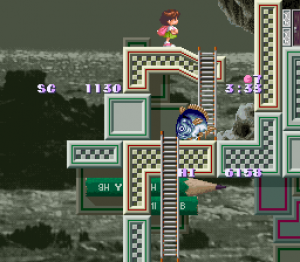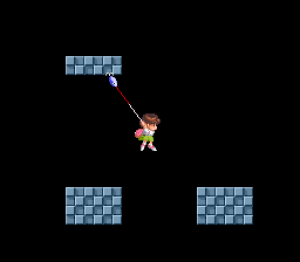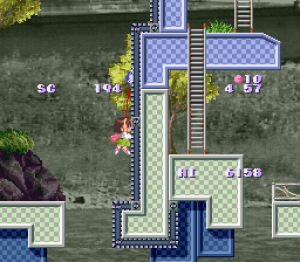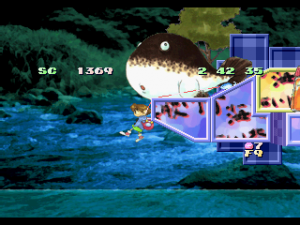[Famicompendium] Umihara Kawase – Ridiculous fishing
Posted on June 7, 2013 by Patrick(@Patricklous) in 3DS, DS, Famicompendium, Features, General Nintendo, News

Author: Patrick
Welcome to Famicompendium – a new regular (or at least semi-regular) column where I’ll be taking a look back at the best and worst the world of import gaming has to offer. From the Famicom to the Wii, I’ll be exploring some of the most fascinating titles to never be officially released in English.
I thought I’d start the column off with an adorable, charming and brutally difficult platformer from the 90s. Lately we’ve been giving a fair bit of coverage to a little 3DS game called Sayonara Umihara Kawase (and hopefully even more once an English version is announced at E3 – don’t leave me hanging, Agatsuma) so it’s worth examining just who the heck Umihara Kawase is and why we’re saying goodbye to her.

Umihara Kawase was originally released for the Super Famicom back in 1994 by a company called TNN (“Think about Needs of Notice for human beings”) shortly before they vanished off the face of the earth. The game follows young Umihara Kawase, a girl who has to explore several “fields” and fight off some freakish sea creatures with the help of her trusty fishing rod. Despite the ugly mishmash of different graphical styles with awfully repetitive music, a ridiculous difficulty curve and absurd premise, it’s actually an incredibly well designed game. There’s a reason that it’s still regarded as one of the best platformers of the era, with copies highly sought after by collectors.

Umihara Kawase plays a bit like Bionic Commando or the more recent cult classic, Ninja Five-O, but comparing it to those games is unfair, because Umihara Kawase places its focus purely on the grappling mechanics. Umihara’s rod isn’t just useful for catching fish – it can hook onto any surface, allowing her to swing between platforms and propel herself through the air. The fishing rod has a unique feel to it, too; having a fishing line made of elastic takes a bit of getting used to, but messing with the length and tension allows for all kinds of crazy stunts. It’s a simple mechanic, but navigating the game’s 49 different “fields” requires an intricate understanding of the game’s physics system.
Fields are really just an abstract series of blocks, but they make for interesting levels because they often have more than one exit – sometimes they lead forward, sometimes backwards. The shortest path tends to be the toughest since skilful use of the fishing rod lets you find hidden doors and skip through large portions of the game. Naturally, Umihara Kawase lends itself well to insane speedruns:
In fact, pulling off a crazy speedrun is practically necessary to reach Field 55 and find the best possible ending (spoiler: just like every other ending, Umihara walks through a door and credits roll). Every field has a time limit, but the longer you play the game for, the more likely it is to suddenly end. Play for thirty minutes and the credits will start rolling as soon as you find the next door. This seems like a bizarre design choice, just like the user interface that hangs halfway down the screen and the giant tadpole that gives birth to tiny frogs, but it’s actually quite brilliant. Because of the time limit and extreme difficulty, Umihara Kawase is the kind of game that demands players practice through repetition. That’s the only way they can get the hang of the mechanics, find new paths and progress further. It sure won’t be for everyone, but it’s an engaging approach to the platforming genre that few developers take.

Despite its super-niche status, Umihara Kawase has seen its fair share of re-releases. The 1997 Playstation sequel switched to 3D graphics and slightly changed the physics, but most importantly it changed the game to be more about pulling off incredible stunts with the fishing rod than dealing with enemies. It’s probably for the best since the relentless, randomly spawning sea creatures in the original game can be downright mean, but that’s not to say that the second outing is any easier. Both games were also repackaged for the DS a few years ago. I can’t exactly speak for the compilation’s quality since I’m put off by the $80 price tag, but it’s apparently the definitive way to play the games. Alternatively, the second Umihara Kawase game (the 2000 re-release with extra fields and no ads) is available on the Japanese Playstation Store for a cool 600 yen.

Curiously, Natsume had plans to localise the PSP version of Umihara Kawase a few years back, but suddenly dropped it – probably because the port was so bad that the few people who wanted to play the game wouldn’t anyway. The future of feminine fishing platformers in the West is still up in the air, but if Natsume can get away with releasing an obscure PSP game about programming robots in 2013, I don’t see why Umihara’s latest outing can’t be localised. Heck, the general manager at developer Agatsuma Entertainment even stated that they’re planning an overseas release. Their last game, Code of Princess, was even self-published in Europe, so it’s looking likely that more people will get the chance to experience this unique gem of a platformer. Or maybe I’m just getting too caught up in the E3 hype.
And that just about wraps it up for this first instalment of Famicompendium!
If there are any games or genres you want to see covered in this column, just name it in the comments section and I’ll see what I can find. I’m trying to legally obtain all the games I write about and that means putting together one massive Rakuten order.
I don’t check the Nintendo Everything Facebook page at all but I feel obligated to link to it anyway!